5 myths about projectors. Myth # 2 - “Color Brightness” - a projector feature invented by marketers

Last time we talked about the myth of operating the projector in a lighted room , and today we will begin a new series of articles on color reproduction from the point of view of the CIE xyY color model. In this part we will see why the “ color brightness ” (of the projector, for example) is important from the point of view of the sRGB standard .

Some theory
Such concepts as “sRGB-projector” and “Rec.709-projector” can be found on the network. The Rec.709 standard is used in HD movies and video (HDTV, Blu-ray) and also uses colors in sRGB space . As a result, one way or another, one cannot speak about the readiness of one or another equipment to reproduce "seven hundred and ninth" content without having confidence in the quality support of this equipment with colors according to the sRGB standard. Wherever you throw - wedge sRGB everywhere !
To understand what colors the sRGB standard defines, we can use the CIE xyY color model . CIE is the “International Commission on Illumination”, which created this model in the 1920s and 1930s. The xyY model is obtained by recalculating another more complex CIE XYZ model to a convenient coordinate system. Since in the model XYZ "Y" means Brightness (Luminance), which is quite a meaningful parameter, we decided to transfer this coordinate to the new model without changes. It turned out familiar to many three-dimensional space of color xyY. The model is incredibly beautiful and comfortable for several reasons. For example, on the Y axis, only the brightness of the color changes, and on the xy plane there are all the shades perceived by a person, that is, our color gamut:

The sRGB standard is the benchmark and is used in the vast majority of the content we deal with every day. Accordingly, it is the standard color for most devices. For sRGB, xyY coordinates of primary colors (so-called “primaries”) are clearly marked. Here they are:
| Coordinate | Red | Green | Blue | White |
| x | 0.64 | 0.3 | 0.15 | 0.3127 |
| y | 0.33 | 0.6 | 0.06 | 0.329 |
| Y | 0.2126 | 0.7152 | 0.0722 | one |
The coordinates x and y can be immediately applied to the plane. For example, here is our “white color”:

But we need white coordinates for reference - white should be exactly according to the measurement results, but itself (like all other shades) is only a product of mixing primary colors, red, green and blue . At least, with the expectation of this, the sRGB standard was created, as the standard for electronic devices that form color by “emitting” rather than reflecting light. Apply to the plane "sRGB-green" and "sRGB-red":

By changing the intensity of the glow (brightness) of green and red, we can achieve any shade on the marked line "green-green-yellow-orange". The elegance of the xyY model is that mixing the two shades on the xy plane gives a color that is exactly on the straight line connecting these two colors. Adding the blue primary coordinate gives the sRGB color gamut :
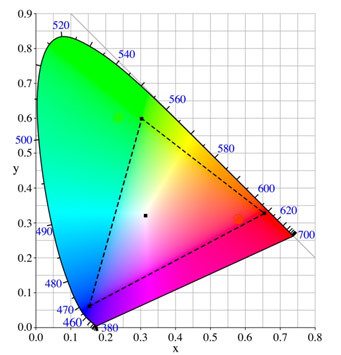
Now we can create any shade by mixing the three primary colors inside the triangle. A monitor, TV or image from a projector on the screen may come closer to this ideal to one degree or another. For example, budget projectors, as a rule, tend to slightly shift the shade of green primary towards yellow, but the color accuracy of any projector strongly depends on the image mode used (“cinema”, “presentation”, actually, “sRGB”, etc. .). This is due to the fact that in different background lighting conditions you can sacrifice, say, color accuracy of certain shades, increase the proportion of the “brightest” green component and make the image brighter, visually increasing its contrast (which is especially important for lit rooms). We talked about this technique and why it “works” in the first part of this series of posts .
Color brightness
Now it's time to answer the main question - is the color brightness , which we constantly pay attention to, so important for the projector to meet the sRGB standard?
To do this, take another look at the coordinates of the primary colors of sRGB:
| Coordinate | Red | Green | Blue | White |
| x | 0.64 | 0.3 | 0.15 | 0.3127 |
| y | 0.33 | 0.6 | 0.06 | 0.329 |
| Y | 0.2126 | 0.7152 | 0.0722 | one |
We find that the Y (brightness) of white is equal to the sum of the brightness of the primary colors (this is a very, very important formulation).
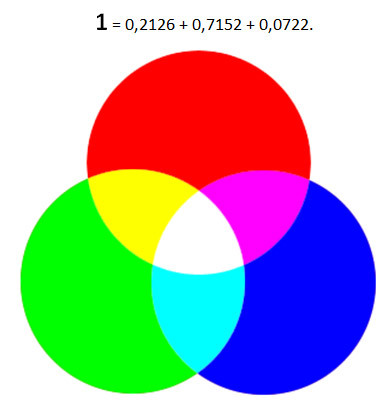
Everything, in general, is logical. To get a whole, you need to add a share. Strictly speaking, no more evidence is required at all.
The Y coordinate is not visible on the two-dimensional xy plane, and it is often overlooked when evaluating the color space of a particular projector, but in reality it does not disappear and is taken into account, for example, in the Delta E formulas used to accurately measure color rendering errors.
Sample image:

3D image diagram (RGB model):
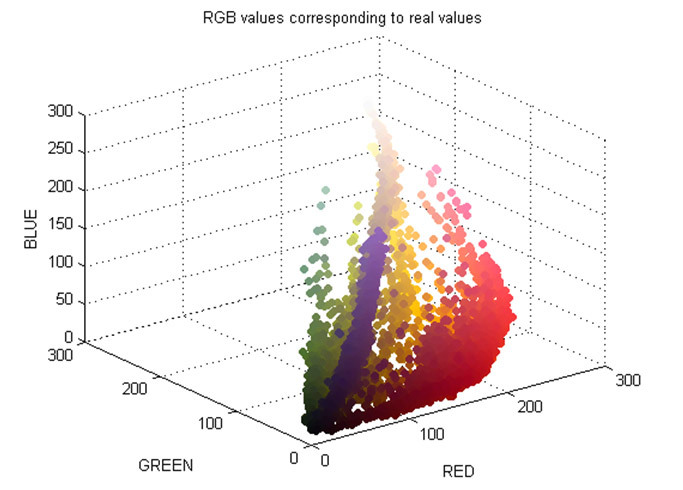
In this example, the 3D color space uses the RGB model, not xyY. In the latter, the color shade would vary within the horizontal plane, and the brightness of the colors would vary vertically. In the case of the RGB model, the principle of vector addition works. Dark colors are concentrated in the lower corner closer to the viewer (coordinates 0, 0, 0). Red shades are shifted to the right, yellows go to the far corner, because they are the result of mixing red and green. But white is located in the far top corner, because it is the result of mixing all the primary colors (the white coordinate is 255, 255, 255).
We often heard that single-matrix DLP projectors using color wheels with additional segments , in addition to red, green and blue, in theory, are not obliged to obey the logic of "color brightness", which states that "white brightness = red brightness + green brightness + brightness blue .

Like, with the same success here you can add magenta, blue, white and gray-brown-crimson. At first glance, it sounds logical: we have other primary colors (primaries), and white is formed on a different principle. However, the sRGB standard has a different opinion on this matter:
- Regardless of the projector device, white is: red + green + blue . If this formula does not work, then the colors are by definition dark and incorrect., because in the sum they do not give an honest white color. And the correct, “textbook” brightness of colors is always determined relative to white. For example, the program for testing the color reproduction ChromaPure proposes to first measure white, and only on the basis of the data obtained does it calculate how much brightness other colors should have. And you can't fool it - if white is formed not only by mixing red, green and blue, then red, green and blue will surely be “rejected” like dark ones. The situation is even worse when, in order to achieve a nameplate brightness in the projector, not a color, but ... a transparent segment of the color wheel is used. Yes, white is created from white. And you can guess what happens with the correctness of the red, green and blue colors in terms of brightness, because some of the energy goes to an elementary increase in the brightness of the image,
- No matter how much a primary color is used in the projector for imaging, three (R, G, B) is always enough to reproduce the entire sRGB palette, and as a result, the color gamut should look like a triangle, as if it were produced by a projector with three basic colors, for example, any Epson projector (3LCD technology). One would like to say that everything else is invented by marketers and wonder-inventors, who add additional shades to the three main colors and only complicate their lives. Indeed, due to the addition of new shades, the addition formula of three components no longer works and it is necessary to “isolate” and reintroduce the fourth or even fifth component, depending on how many colors the genius inventor decides to “mix” into the color wheel. Judging by the experience we have, such complication often leads to increased banding (coarse color transitions).
- In fact, to be frank, the use of additional segments still has a quite intelligible goal, and it is associated with an increase in brightness in an attempt to approach this parameter to three-matrix projectors.
Curious facts
Pay attention to how small the proportion of brightness is blue in white - green is about 10 times brighter . This is it, the sRGB standard, taking 100% as much color as it is required to produce pure white. And blue is required less than the rest.
Speaking of "100% blue." In addition to the sRGB-space, there is also an RGB signal. Ideally, the sRGB projector should have a full match between the RGB signal and the resulting image. The peculiarity of the RGB signal is that it simply tells the device that the pixel should be, for example, 100% red, 100% green and 0% blue. As a result, we get yellow color in the color space in which the device operates. Assuming that it is a yellow color in the sRGB space, we can calculate the exact coordinate of the yellow in the xyY space.
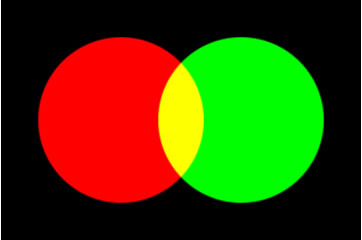
What do you think, what is the Y coordinate (brightness) of yellow? Right! It is strictly equal to the sum of the brightness of green and red .
Now imagine what a single-matrix projector , which, unlike a 3LCD projector, does not mix a stream of white light, divided into three components , but successively displays first red, then green, then blue, and often, meanwhile, also just “white”. "Through the transparent segment of the color wheel.

You can achieve accurate color rendition of the desired yellow hue only by completely eliminating the transparent wheel segment and thus losing up to a third or even more of the original brightness of the lamp, because at any given time only that small part of the light that is transmitted by the wheel filter hits the screen.

This is a fundamental difference of technology , the understanding of which once and for all opens the eyes to why single-chip DLP projectors are a compromise. Choose: either some kind of accurate color reproduction according to the sRGB standard, or a bright picture obtained by mixing in the “white” light of the lamp, which noticeably reduces the brightness of the colors, which by light means a loss of legibility and contrast of the color image. Well, the notorious "rainbow", by itself, in any mode of operation, due to the fact that the image is formed by flickering, and not by a continuous stream.
As we have said, the RGB signal goes in a normalized form, that is, 100% means the brightness that is necessary to get white in total with the other two colors. Of course, many people know that colors in RGB are encoded depending on the bit depth of the color. For example, with eight-bit encoding, each color can take values from 0 to 255 - the white color will be (255, 255, 255). You can’t jump over your head: if the projector was told to show 255 only on one of the color channels, it must do everything possible to “get” to the primary standard sRGB and period. Not hit - not sRGB! Let's goodbye.

The 3LCD proctor in this case does not even “soar” and gives 100% blue to the screen, while the others, based on 1-chip technology, give such a discolored blue that it blends with the other shades on the screen, especially if they are in the background:

And if you turn on the light, it will be even worse ...
Future note
What about the promising color spaces that await us in connection with the massive transition to HDR? And everything is the same: they are all based on the RGB principle, only the “triangle” of the color gamut will be more:
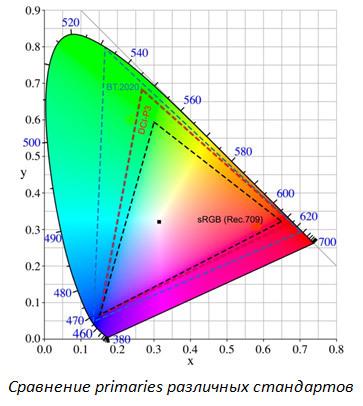
The only difference is that other coordinates of the three primary colors are taken, different from those specified in the sRGB standard.
findings
We often and in the case say that the color brightness of the projector should be equal to the maximum (in white) and give two brightness values for their projectors. For illustration, we like to give this picture:

And also - a link to this site , which contains the measurements of the maximum and color brightness of a number of projectors. Today we told why this cannot be considered a whim. The parameter "color brightness" exists in order to:
- describe only one of a number of aspects of color rendition. And, although this parameter is not the only one, it can be easily measured with a simple light meter;
- clearly demonstrate the advantage of three-matrix projectors (in our case, 3LCD technology is implied) over one-matrix ones, especially when working in illuminated rooms and other conditions when all the available brightness of the projector is used.
So it goes.
